Voices of Memory
Sound Art in Public Spaces
Listening Together: Anticipating Christina Kubisch's "Voices of Memory"
Sound Bridge
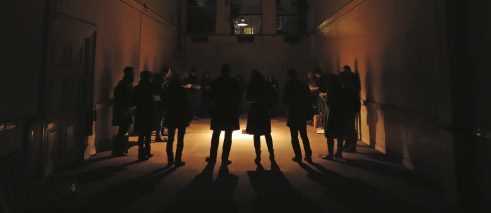 Dennis McNulty: A cloud of soft equations; 2014.
| Image courtesy of the artist and Pallas Project/Studios. Photo: Eliana Salazar.
Encountering a sound that is placed in a specific environment is a difficult experience to describe. The moment in which we become aware of this other presence is blurry, as is the moment in which we discover we have slipped beyond its territory. It welcomes interference from its surroundings, and invites us to reconstitute its form through our own movements. We pause our conversation, maybe wait for others to pass by, or for the sound of a distant plane to fade away, pursuing not an absolute silence within which we might evaluate it, but a series of experiential samples through which we can begin to plot its trajectory.
Dennis McNulty: A cloud of soft equations; 2014.
| Image courtesy of the artist and Pallas Project/Studios. Photo: Eliana Salazar.
Encountering a sound that is placed in a specific environment is a difficult experience to describe. The moment in which we become aware of this other presence is blurry, as is the moment in which we discover we have slipped beyond its territory. It welcomes interference from its surroundings, and invites us to reconstitute its form through our own movements. We pause our conversation, maybe wait for others to pass by, or for the sound of a distant plane to fade away, pursuing not an absolute silence within which we might evaluate it, but a series of experiential samples through which we can begin to plot its trajectory. If this sound represents an act of memory, it does so within these parameters, within this open framework. There is only a suggestion, never a binding agreement, and only an indistinct (but confident) nod to the monumental.
I anticipate my first encounter with Christina Kubisch’s Voices of Memory for the Memorial Gardens on these terms.
The work is sited just on the edge of Dublin, not quite on the periphery, but certainly off-centre. The geographic siting of the installation parallels its identity as an artistic gesture: It does not slot in within a (local) canon of projects that pursue similar experiential or formal territory.
The role of sound art in Dublin does not manifest as it does in Germany, where we identify continuities between subsequent generations of artists, and persistent oscillations between experimentation and support that coax the medium to become refined (and re-defined). In Dublin, listening cultures - and the forms of output that they engender - ebb and flow, but rarely persist in the foreground. I’m limiting myself to consider sound art in Dublin - not in Ireland; although it is a small country, I think there is something to be gained from setting Kubisch’s work along the Liffey within a local continuum. There is a unique freedom of working with this medium that is quite specific to this place. Yet in this city, I recall significant listening memories as linking to diverse - and not specifically sonic - artistic frameworks. Perhaps these references destabilize a concise definition of sound art, but they suggest a local premise for Kubisch’s Voices of Memory as it is integrated with the quiet landscape to the west of Dublin, bridging between different moments in which the act of listening becomes primary.
Four Points of Reference
We’ll begin with a memory from 2002. The installation DIN (co-curated by Slavek Kwi and Sarah Pierce) created a temporary listening library formed from hundreds of recordings that Kwi had amassed by trading releases with other artists, hinting at the infinity of exchanges that led to the formation of this collection. Set on street level in Temple Bar in the (now-defunct) Arthouse gallery, DIN provided a temporary sanctuary for curious listeners. The exhibition disclosed both Kwi's and Pierce’s curiosities, foregrounding open modes of exchange and experimentation with archival formats.
A year later in 2003, Ultra-red (a collective primarily based in Los Angeles at that time) embarked on a public art project in Dublin titled The Debt, delving into issues of community displacement and activism through the lens of the Breaking Ground commissioning scheme linked to the housing regeneration project in Ballymun. Ultra-red’s format of tactical ambient sound assemblage became embedded within a local consciousness, manifesting in public discussions, performances and eventually a 12-CD document reflecting (amongst other things) the problematics of its own structure. Although it appeared as a tangent initiated by an outside energy, The Debt suggested new models of listening in Dublin, implicating pressing urban issues via acoustic strategies.
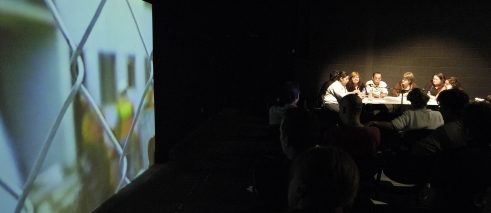 Ultra-red: The Debt; A dialogue between social housing residents from Pico Aliso in Los Angeles and residents from Ballymun in Dublin; Project Arts Centre; 28 July 2003. Image courtesy of the artist.
| Photo: Pierre Jolivet
The next memory that comes to mind is walking down to Christchurch Cathedral on the evening of 21 June 2012. The sound of cars on the wet pavement was slick and present. Garrett Phelan’s New Faith Love Song commenced at 9 pm. The bell towers from two adjacent cathedrals performed a minimal, synchronized composition. I began with a scattered group of people at a chosen location situated between the two cathedrals, but quickly set off to explore the event as it unfolded, following the sound of the bells as they echoed from street to street, performing on the infinity of brick and concrete surfaces that constitute the city. The new faith at stake was clearly plural, to be discovered on one’s own terms.
Ultra-red: The Debt; A dialogue between social housing residents from Pico Aliso in Los Angeles and residents from Ballymun in Dublin; Project Arts Centre; 28 July 2003. Image courtesy of the artist.
| Photo: Pierre Jolivet
The next memory that comes to mind is walking down to Christchurch Cathedral on the evening of 21 June 2012. The sound of cars on the wet pavement was slick and present. Garrett Phelan’s New Faith Love Song commenced at 9 pm. The bell towers from two adjacent cathedrals performed a minimal, synchronized composition. I began with a scattered group of people at a chosen location situated between the two cathedrals, but quickly set off to explore the event as it unfolded, following the sound of the bells as they echoed from street to street, performing on the infinity of brick and concrete surfaces that constitute the city. The new faith at stake was clearly plural, to be discovered on one’s own terms.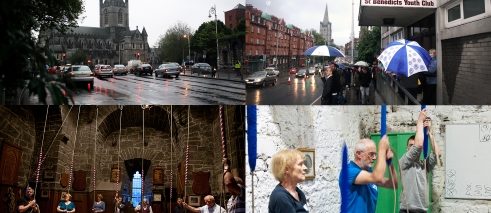 Garrett Phelan: New Faith Love Song; Performance documentation; Irish Museum of Modern Art; 2012. Image courtesy of the artist.
| Photos: Barry Keogh & Miranda O’Driscoll
Finally, I remember shuffling along with a tightly-knit crowd for Dennis McNulty’s performance A Cloud of Soft Equations in 2014. I followed the sound of others’ footsteps (as much as their physical presence) through a series of carefully scripted encounters – primarily presented via dialogue – within the frozen architecture of the former Pathology Department of University College Dublin in Earlsfort Terrace, vacant since 2007. Our path led through old lecture halls and static passageways, setting the stage for a labyrinth of stanzas alternating between live and pre-recorded readings. The relationship between the voice and interior architecture (and between presence, technology, and absence) was tangible, each voice warping the relationship further as time within this space prolonged.
Garrett Phelan: New Faith Love Song; Performance documentation; Irish Museum of Modern Art; 2012. Image courtesy of the artist.
| Photos: Barry Keogh & Miranda O’Driscoll
Finally, I remember shuffling along with a tightly-knit crowd for Dennis McNulty’s performance A Cloud of Soft Equations in 2014. I followed the sound of others’ footsteps (as much as their physical presence) through a series of carefully scripted encounters – primarily presented via dialogue – within the frozen architecture of the former Pathology Department of University College Dublin in Earlsfort Terrace, vacant since 2007. Our path led through old lecture halls and static passageways, setting the stage for a labyrinth of stanzas alternating between live and pre-recorded readings. The relationship between the voice and interior architecture (and between presence, technology, and absence) was tangible, each voice warping the relationship further as time within this space prolonged.
Listening Communities
As we consider these four memories, it’s clear that we have strayed away from the familiar territory of the sound installation. We are discovering other modes of exchange, in which we establish a common ground through the formation of a listening community. I’m going to position the idea of the listening community somewhere outside (or beyond) the idea of the audience: A listening community - even if it is formed via a brief event - has something at stake that the audience does not. In Kwi's and Pierce’s DIN there is an unspoken contract that binds listeners to the structure of display, recalling the expectant moment of returning to the library to find the next book in a series. Ultra-red’s The Debt implicates its listeners in an attempt to interpret an urban transformation that leads further and further away from a comfortable resolution. In Phelan’s New Faith Love Songs there is the sudden appearance and disappearance of a signal that lifts us out of the rituals of the city and its sounding infrastructures (and their historical frameworks) that are set rigidly in place. McNulty’s A Cloud of Soft Equations relies on the close confines of its setting and the precise directive of its sequencing to bind listeners within a receptive state of shared sensitivity.
Kubisch’s Voices of Memory addresses a distinct community of listening as well. Emerging in 2016 amidst an array of memorial productions (some sharp and legible, others struggling to negotiate the complexities that staging such a return inevitably implies), I feel a sense of calm thinking of the names and voices that constitute the raw material of Voices of Memory being filtered and processed towards a new assemblage (that we will experience as the completed work). We deserve a chance to approach this subject through such layered abstraction. The invitation is generous: It establishes a sense of trust between the artist, the site, and the audience, allowing time and space for awareness to form over the course of the work’s duration.
Noise and Silence
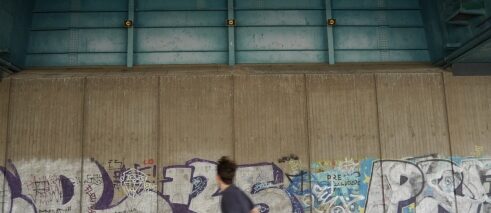 Christina Kubisch: Rheinklänge; 2013. Three golden speakers under a bridge which diffuse a kind of „romantic“ soundscape, brutally interrupted by the sounds of cars on the bridge above. Image courtesy of the artist.
| Photo: Christina Kubisch
My first conversation with Christina Kubisch took place in front of an audience. I was curating a symposium titled Beyond Noise and Silence: Listening for the City in 2015. Kubisch gave an artist talk at the National College for Art and Design (NCAD) in Dublin for the first evening of the symposium. After an intimate presentation - detailing the structures, techniques, experiences, and motivations behind a wide array of her projects - I joined her on stage to discuss her recent participation in the bonn hoeren project. Curated by Carsten Seiffarth, bonn hoeren developed a unique body of work through the premise of working with a city sound artist for four consecutive years in the city of Bonn (Germany). Kubisch was chosen to work in this position in 2013, as the fourth (and final) city sound artist in this series of integrated residencies. One of the outputs of her time in Bonn - the sound installation rheinklänge, an installation work placing two distinct sonic gestures situated along the Rhine - provided a solid foundation for our conversation.
Christina Kubisch: Rheinklänge; 2013. Three golden speakers under a bridge which diffuse a kind of „romantic“ soundscape, brutally interrupted by the sounds of cars on the bridge above. Image courtesy of the artist.
| Photo: Christina Kubisch
My first conversation with Christina Kubisch took place in front of an audience. I was curating a symposium titled Beyond Noise and Silence: Listening for the City in 2015. Kubisch gave an artist talk at the National College for Art and Design (NCAD) in Dublin for the first evening of the symposium. After an intimate presentation - detailing the structures, techniques, experiences, and motivations behind a wide array of her projects - I joined her on stage to discuss her recent participation in the bonn hoeren project. Curated by Carsten Seiffarth, bonn hoeren developed a unique body of work through the premise of working with a city sound artist for four consecutive years in the city of Bonn (Germany). Kubisch was chosen to work in this position in 2013, as the fourth (and final) city sound artist in this series of integrated residencies. One of the outputs of her time in Bonn - the sound installation rheinklänge, an installation work placing two distinct sonic gestures situated along the Rhine - provided a solid foundation for our conversation.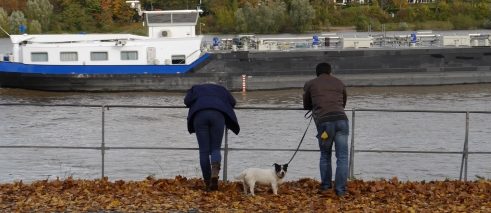 Christina Kubisch: Rheinklänge; 2013. Passers-by stopping to listen to sounds from two hydrophones transmitting live the underwater sounds of the ships in the river. Image courtesy of the artist.
| Photo: Christina Kubisch
My questions were tactical and direct: At the time I was working on a similar project in Dublin titled The Manual for Acoustic Planning and Urban Sound Design, in which I was exploring not the role of the city sound artist, but that of the urban acoustic planner. My project was sited within Dublin City Council, and when I spoke with Kubisch, I was working on the permanent sound installation Continuous Drift for Meeting House Square in Temple Bar, Dublin’s cultural quarter (and also its most popular tourist destination). Conversations like this, focused on the issues that arise when installing a sound installation in public space, with a focused audience are quite rare in Dublin.
Christina Kubisch: Rheinklänge; 2013. Passers-by stopping to listen to sounds from two hydrophones transmitting live the underwater sounds of the ships in the river. Image courtesy of the artist.
| Photo: Christina Kubisch
My questions were tactical and direct: At the time I was working on a similar project in Dublin titled The Manual for Acoustic Planning and Urban Sound Design, in which I was exploring not the role of the city sound artist, but that of the urban acoustic planner. My project was sited within Dublin City Council, and when I spoke with Kubisch, I was working on the permanent sound installation Continuous Drift for Meeting House Square in Temple Bar, Dublin’s cultural quarter (and also its most popular tourist destination). Conversations like this, focused on the issues that arise when installing a sound installation in public space, with a focused audience are quite rare in Dublin.We honed in on working with sound installations in public spaces, the need to spend time listening on site, adjusting and re-adjusting volume levels and remaining an attentive listener. These phases of installing work are often protracted, as hours (and days) unfold through dynamic passages of other sounds approaching and retreating within the acoustic territories that we occupy. Kubisch emphasized that ensuring a sound installation is not perceived as the primary element within these overlapping territories grants it the flexibility to be perceived integrated within the landscape, when approached from the diverse experiences of people who encounter the work.
This sensitivity lies at the core of these works: It engenders a contradictory presence, one that gives in to its surroundings while simultaneously asserting its form with relentless determination. Listeners are immediately implicated in this tension, and as I was thinking before, I can’t help but consider this format as an ally when approaching the subjects that Voices of Memory considers. Thinking within the structure of the piece, it as if the subject needn’t be revealed. The sound of a faint communication can be absorbed in the landscape, developing a resonance through its own internal semantics as it is produced, slipping between voice, music, sound, memory, and silence. This is enough.
Time and Landscape
To conclude, I need to take a step away from Dublin to consider Max Neuhaus’ Times Square in New York. Installed in 1977, Times Square is an archetypal sound installation set within a complex, evolving landscape. Christoph Cox summarizes the work’s temporality as follows:
“... [T]he piece is a profound invitation to duration. Twenty-four hours a day, the installation has broadcast a stream of rich metallic drones from deep inside a subway vent on a pedestrian island in New York’s busiest district. Audible but unobtrusive, the drones blend with and subtly alter the bustling sonic environment. This sonic stream is continuous, but it is experienced by visitors and passersby at particular moments within this temporal continuum. Such moments of conscious or unconscious apprehension serve as opening onto a flow of duration of which we are a part but that also surpasses us” (Cox, 2009, p. 124).[1]
Without grappling with the notion of infinite duration so literally, Kubisch’s Voices of Memory employs a similar temporal gesture to connect us with the past. I think of open structures and forms in Kubisch’s work - from the playful geometries of her early installations to the mixture of processed and unprocessed sounds in her recordings, from the variety of scales through which her practice is applied to the participatory framework declared through her Electrical Walks series. I anticipate an element of this freedom emerging somehow through the temporal dimension of Voices of Memory.
The work’s temporal - or durational - dimension establishes a unique gesture in Dublin. Set alongside the daily rituals of the park, the geometry of its pathways, and the continuous presence of the Liffey, the interlocking patterns of names being revealed through Voices of Memory forms a new experiential layer that is integrated within the landscape. Let’s consider this integration through the unifying concept of urban atmospheres. Gernot Böhme discusses the atmosphere of cities in relation to sound the active role of the public:
“The question of sound atmospheres is directly related to the dimension of lifestyles, understood as generators of urban atmospheres. In terms of street noise, it makes a difference whether it is customary for people to honk their horns or not, what type of car they drive, whether music can be heard through their open windows, whether the names of goods are shouted out, or whether ‘alluring’ music comes from the boutiques. These are just some aspects: Through their lifestyles, the inhabitants of the city are also, always, producers of its atmosphere” (Böhme, 2014, p. 55). [2]
I would expand Böhme’s consideration by stating that the urban (sonic) atmosphere is also determined by how people listen in a given city. This is, after all, an experiential dimension of urban space, and as such, we are implicated in its production even as we position ourselves as receivers. The premise of Voices of Memory pursues a new mode of listening in Dublin, one that reminds us to take more time to consider how actively sound performs to reveal the experiential landscape, both past and present.
[Footnotes]
[1] Cox, C. (2009). "Installing Duration: Time in the Sound Works of Max Neuhaus." In L. Cooke and K. Kelly (Eds.), Max Neuhaus: Times Square, Time Piece Beacon (pp. 113-132). New York, NY: Dia Art Foundation.
[2] Böhme, G. (2014). "Urban Atmospheres: Charting New Directions for Architecture and Urban Planning." In C. Borch (Ed.), Architectural Atmospheres: On the Experiences and Politics of Architecture (pp. 42-59). Basel: Birkhäuser.
Sven Anderson
Sven Anderson is an artist working between Ireland and the US since 2001. Anderson’s work explores the act of listening within diverse architectural, physical, social, and emotional contexts. His practice is a discursive platform that operates through artistic intervention, academic publication, participatory processes, and interactive design.
Anderson’s installations and performances are parasitical, feeding off of details of the immediate built environment, the bodies of the audience, and fragments of local history and ecology to suggest emergent, site-specific forms. His ongoing public art project The Manual for Acoustic Planning and Urban Sound Design received the European Soundscape Award issued by the European Environmental Agency (EEA) in 2014.
Through this work and other projects, Anderson creates active interfaces between artists, architects, urban planners, and policymakers, identifying spaces for sustainable research and production. Anderson’s permanent artwork Continuous Drift blurs the boundaries between public sound installation, architectural intervention, and curatorial framework.